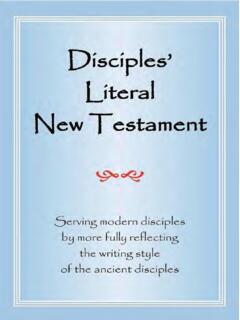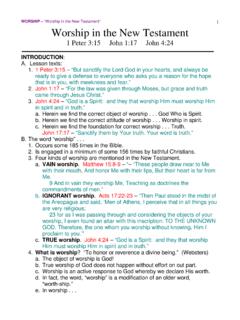Transcription of THE GREEK TEXT OF THE NEW TESTAMENT
1 THE GREEK TEXT OF THE NEW TESTAMENT . by Windell H. Gann February 27, 1978. THE GREEK TEXT OF THE NEW TESTAMENT . Outline I. An Enumeration of GREEK New TESTAMENT Manuscripts .. p. 1. A. Papyri .. p. 1. B. Uncials .. p. 1. C. Minuscules .. p. 2. D. Lectionaries .. p. 2. II. Cataloguing the New TESTAMENT Manuscripts .. p. 3. III. Collating the New TESTAMENT Manuscripts .. p. 4. IV. Families of New TESTAMENT Manuscripts .. p. 6. A. Western family .. p. 6. B. Alexandrian family.. p. 7. C. Byzantine family .. p. 8. D. Caesarean family.. p. 10. V. Causes of Errors in Textual Transmission .. p. 13. VI. Future Critical Editions of the GREEK New TESTAMENT .. p. 15. Carts and Diagrams Enumeration of GREEK New TESTAMENT Manuscripts.
2 P. 2. Text-type Nomenclature .. p. 6. Theory of Local texts .. p. 9. Chart of Text Families.. p. 11. Charts of Family Witnesses and Textual Theory .. p. 12. BIBLIOGRAPHY ..p. 17. THE TEXT OF THE GREEK NEW TESTAMENT . I. An Enumeration of the GREEK New TESTAMENT Manuscripts We believe that under God's providence a vast fleet of documents have transported the New TESTAMENT text across the sea of time. For expert information in this field we turn to Kurt Aland who currently assigns official numbers to newly discovered manuscripts of the GREEK New TESTAMENT and to Bruce Metzger author of many articles and books concerning the New TESTAMENT text. Kurt Aland, The GREEK New TESTAMENT : Its Present and Future Editions, JBL, Vol 87 (1968).
3 Burce Metzger, The Text of the New TESTAMENT . 1968. How many New TESTAMENT manuscripts are there? The 1968 statistic as presented by Kurt Aland is that there are 5, 255 known manuscripts which contain all or part of the GREEK New TESTAMENT . A. Papyri. The earliest of these GREEK New TESTAMENT manuscripts are the papyri, written on an ancient type of writing material made from the fibrous pith of the papyrus plant, which in ancient times grew plentifully along the river Nile. Eighty-one of these papyri have now been discovered, many of them fragments. The most important of these papyrus manuscripts are the Chester Beatty Papyri and the Bodmer Papyri. The Chester Beatty Papyri were published in 1933-37 and include Papyrus 45 (Gospels and Acts, c.)
4 225 A. D.), Papyrus 46 (Pauline Epistles, c. 225 A. D.), and Papyrus 47 (Revelation, c. 275 A. D.). The Bodmer Papyri were published in 1956-62. The most important of these are Papyrus 66 (John, c. 200 A. D.), and Papyrus 75 (Luke and John 1:15 c. ). B. Uncials. All the rest of the GREEK New TESTAMENT manuscripts were of velum (leather), except for a few late ones in which paper was used. The oldest of the velum manuscripts are written in uncial (capital) letters. These uncial manuscripts now number 267. The three oldest complete (or nearly complete) uncial manuscripts are B (Codex Vaticanus), Aleph or ! (Codex Sinaiticus), and A (Codex Alexandrinus). 1. Codex B was written about the middle of the 4th century and is the property of the Vatican Library at Rome.
5 It is not known when it arrived there but it must have been before 1475 since it is mentioned in a catalogue of the library made that year. The Text of the GREEK New TESTAMENT 2. 2. Codex ! was discovered by Tischendorf in 1859 at the Monastery of St. Catherine at the foot of Mt. Sinai. Tischendorf persuaded the monks to give it as a present (receiving in return money and favors) to the Czar of Russia. In 1933 it was purchased from the Russian government by the Trustees of the British Museum. It is generally considered by scholars to have been written in the second hail of the 4th century. 3. Codex A was for many years regarded as the oldest extant New TESTAMENT manuscript. It was given to the King of England in 1627 by Cyril Lucar, patriarch of Constantinople, and is now kept in the British Museum.
6 Scholars date it from the first haLf of the 5th century. 4. Other important uncial manuscripts are W (Gospels, 4th or 5th century), D. (Gospels and Acts, 5th or 6th century), and D2 (Pauline Epistles, 6th century). C. Minuscules. About the beginning of the 9th century minuscule (small letter). handwritting began to be used for the production of books. Thus all the later New TESTAMENT manuscripts are minuscules. According to Aland, 2,764 minuscules have been catalogued. These date from the 9th to the 16th century. D. Lectionaries. Another important class of GREEK New TESTAMENT manuscripts are the lectionaries. These are service books which contain in proper sequence the text of the passages of Scripture appointed to be read at the worship services of the church.
7 These lectionaries are of two kinds, the synaxaria, which begin the year at Easter, and the menologia, which begin the year with the first of September. Aland puts the number of lectionary manuscripts catalogued in 1968 at 2,143. SUMMARY. Enumeration of GREEK New TESTAMENT Manuscripts List IV List VII. Papyri 48 81. Majuscules 208 267. Minuscules 2370 2764. Lectionaries 1609 2143. Total: 4235 5255. List IV compiled in 1954 by von Dobschutz List VII compiled in 1967 by K. Aland. The Text of the GREEK New TESTAMENT 3. II. Cataloguing the New TESTAMENT Manuscripts A. Among the very first tasks of New Textament textual criticism involve the discovery and cataloguing of the GREEK manuscripts.
8 As early as 1550 the scholarly printer Stephanus began to do this. He placed in the margin of his third printed .edition of the GREEK text variant readings taken from 15 manuscripts, which he indicated by GREEK numbers. One of these manuscripts was D and another L , and most of the rest have been identified with minuscule manuscripts in the Royal (National) Library at Paris. B. In 1657 the English scholar Brian Walton included in the 6th volume of his great Polyglot Bible the variant readings of Stephanus and also those of 15 other manuscripts. These were listed along with the libraries in which they were kept. C. In 1707 John Mill published his monumental edition of the New TESTAMENT in which almost all the available evidence of the GREEK manuscripts and the early versions was presented.
9 Mill made use of 82 GREEK New TESTAMENT manuscripts in his epoch making work. D. The modern system of cataloguing the New TESTAMENT manuscripts was introduced by J. J. Wettstein in his two volume edition of the New TESTAMENT , published at Amsterdam in 1751-52. He designated the uncial manuscripts by capital letters and the minuscie manuscripts by Arabic numerals. Wettstein catalogued about 125 GREEK New TESTAMENT manuscripts. (Parvis, New TESTAMENT Manuscript Studies, p. 6). E. The 19th century has seen a tremendous speed-up of GREEK New TESTAMENT manuscript catalogueing. During the years 1820-36 J. M. A. Scholz listed 616. manuscripts which had not previously been known. F. In the four editions of his Introduction to the Criticism of the New TESTAMENT (1861-94) F.
10 H. A Scrivener extended the catalogue to almost 3,000 manuscripts. G. Between the years 1884 and 1912 C. R. Gregory enlarged this list. H. After Gregory's death in World War I, the task of registering newly discovered manuscripts was taken over by von Dobschuetz. I. At present this responsibility rests with Kurt Aland, and as previously stated, in 1968 he listed the present number of GREEK New TESTAMENT manuscripts at 5,255. The Text of the GREEK New TESTAMENT 4. III. Collating the New TESTAMENT Manuscripts A. After a manuscript is discovered and catalogued, it must be studied and any difference between it and a well known printed text be published. Usually this is done by collating (comparing) the manuscript to a printed text and noting the variant readings from the printed text.









